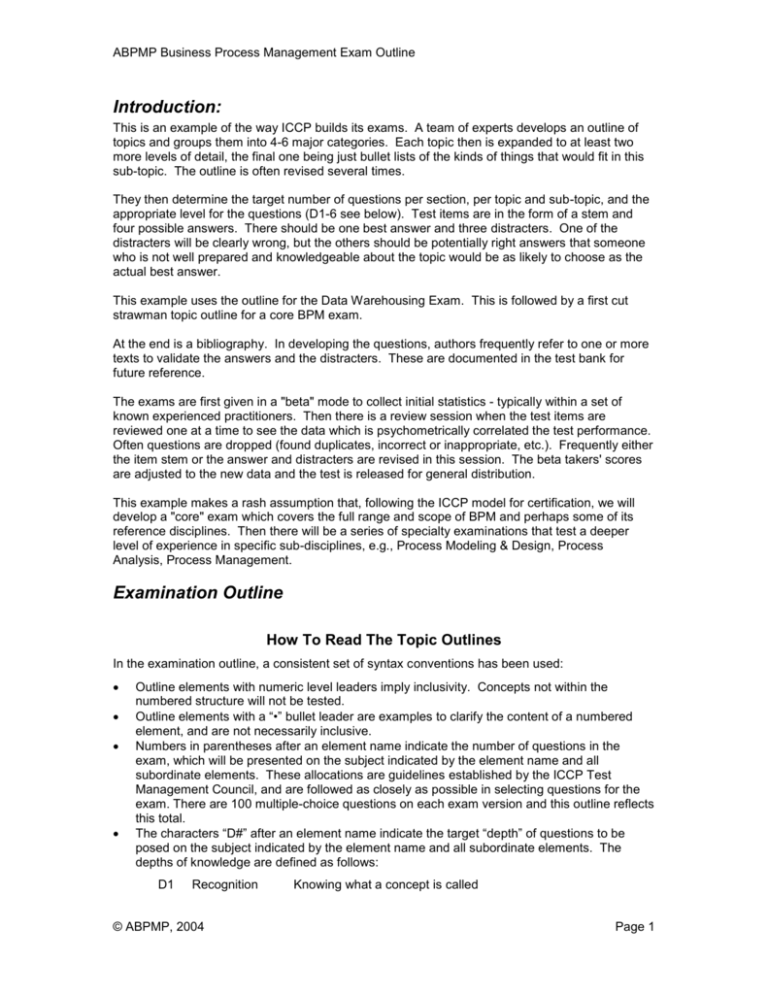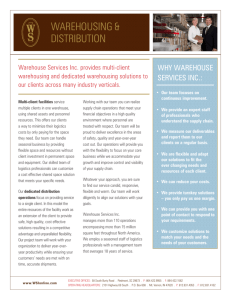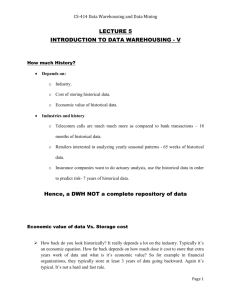
ABPMP Business Process Management Exam Outline
Introduction:
This is an example of the way ICCP builds its exams. A team of experts develops an outline of
topics and groups them into 4-6 major categories. Each topic then is expanded to at least two
more levels of detail, the final one being just bullet lists of the kinds of things that would fit in this
sub-topic. The outline is often revised several times.
They then determine the target number of questions per section, per topic and sub-topic, and the
appropriate level for the questions (D1-6 see below). Test items are in the form of a stem and
four possible answers. There should be one best answer and three distracters. One of the
distracters will be clearly wrong, but the others should be potentially right answers that someone
who is not well prepared and knowledgeable about the topic would be as likely to choose as the
actual best answer.
This example uses the outline for the Data Warehousing Exam. This is followed by a first cut
strawman topic outline for a core BPM exam.
At the end is a bibliography. In developing the questions, authors frequently refer to one or more
texts to validate the answers and the distracters. These are documented in the test bank for
future reference.
The exams are first given in a "beta" mode to collect initial statistics - typically within a set of
known experienced practitioners. Then there is a review session when the test items are
reviewed one at a time to see the data which is psychometrically correlated the test performance.
Often questions are dropped (found duplicates, incorrect or inappropriate, etc.). Frequently either
the item stem or the answer and distracters are revised in this session. The beta takers' scores
are adjusted to the new data and the test is released for general distribution.
This example makes a rash assumption that, following the ICCP model for certification, we will
develop a "core" exam which covers the full range and scope of BPM and perhaps some of its
reference disciplines. Then there will be a series of specialty examinations that test a deeper
level of experience in specific sub-disciplines, e.g., Process Modeling & Design, Process
Analysis, Process Management.
Examination Outline
How To Read The Topic Outlines
In the examination outline, a consistent set of syntax conventions has been used:
Outline elements with numeric level leaders imply inclusivity. Concepts not within the
numbered structure will not be tested.
Outline elements with a “•” bullet leader are examples to clarify the content of a numbered
element, and are not necessarily inclusive.
Numbers in parentheses after an element name indicate the number of questions in the
exam, which will be presented on the subject indicated by the element name and all
subordinate elements. These allocations are guidelines established by the ICCP Test
Management Council, and are followed as closely as possible in selecting questions for the
exam. There are 100 multiple-choice questions on each exam version and this outline reflects
this total.
The characters “D#” after an element name indicate the target “depth” of questions to be
posed on the subject indicated by the element name and all subordinate elements. The
depths of knowledge are defined as follows:
D1
Recognition
© ABPMP, 2004
Knowing what a concept is called
Page 1
ABPMP Business Process Management Exam Outline
D2
Differentiation
D3
D4
D5
Description
Usage
Structure
D6
Construction
Knowing the external differences between a concept and a
neighboring concept
Knowing the external characteristics of a concept
Knowing how to use instances of the concept and why
Knowing the internal structure of the concept — its components
and the relationships among these components
Knowing how to put together instances of the concept tailored to
specific purposes
References
There is a selected bibliography at the end of the outline, which together thoroughly cover the
subject areas in the exam. The reference selections given are not exhaustive, but representative.
Exam Topic Outline
First Level Outline
Example: Data Warehousing Exam
1.0 Data Warehousing Function
(19) Section 1 Total
2.0 Data Warehouse Infrastructure Creation / Maintenance
(21) Section 1 Total
3.0 Data Warehousing Analysis and Design
(27) Section 3 Total
4.0 Data Acquisition and Cleansing
(10) Section 4 Total
5.0 Data Warehouse Implementation & Operation
(23) Section 5 Total
Second Level Outline
Example: Data Warehousing Exam
1.0 Data Warehousing Function
1.1 Planning
1.2 Organization
1.3 Roles and Responsibilities
(19) Section 1 Total
(8)
D4
(3)
D3
(8)
D3
2.0 Data Warehouse Infrastructure Creation / Maintenance
2.1 Data Warehouse Architectures
2.2 Data Warehouse Database Architectures Types
2.3 Tools and Technology Types
(21) Section 1 Total
(5)
D4
(6)
D4
(10)
D3
3.0 Data Warehousing Analysis and Design
3.1 Requirements Analysis
3.2 Data Warehouse Model Types and Components
3.3 Data Modeling for the Data Warehouse
(27) Section 3 Total
(9)
D5
(9)
D5
(9)
D5
4.0 Data Acquisition and Cleansing
4.1 Source Data Acquisition
4.2 Source Data Cleansing
(10) Section 4 Total
(5)
D5
(5)
D3
5.0 Data Warehouse Implementation & Operation
5.1 Development
5.2 Deployment
© ABPMP, 2004
(23) Section 5 Total
(13)
D3
(5)
D3
Page 2
ABPMP Business Process Management Exam Outline
5.3 Ongoing Support and Maintenance
(5)
D3
Third & Fourth Level Outline
Example: Data Warehousing Exam
1.0. Data Warehousing Function
(19) Section 1 Total
1.1. Planning
(8)
D4
1.1.1. Organizational Business Drivers
Business reasons
Benefits
Sponsors
1.1.2. Data Warehousing Plans
Strategic data warehousing plan / justification
Incremental development process plan
Organizational structure plan and budgets
Warehousing metadata management plan
Readiness assessments
Relationship management plan (vendor, customer, employee)
Data integration plan
Data quality management plan
Data acquisition and cleansing plans
Warehousing standards plan
Project plans and deliverables
Implementation, testing plans
Deployment plans
Deployment readiness assessments
Operations and management plans
1.1.3. Policies / Standards / Processes / Procedures / Guidelines
Internal to data warehousing organization
Warehousing customer data / metadata access guidelines
1.2. Organization
1.2.1. Types of Project Team / Staff Skills Required
Project management
Warehouse organization management
Information / data architecture
Data modeling and metamodeling
Database administration
Business analysis
Applications development
Middleware
System administration
Metadata administration
Decision support tools
Security
Networking
Configuration management
Web master
Statistical analysis
Business knowledge
1.2.2. Project Team / Staff Training
Orientation for new project team members, employees, business users
Continuing education for required skills, retraining
1.2.3. Communication
Marketing data warehousing services and benefits
Customer education / training
© ABPMP, 2004
(3)
D3
Page 3
ABPMP Business Process Management Exam Outline
Publishing newsletters and web site news
1.3. Roles and Responsibilities
(8)
D3
1.3.1. Project
Project scope and objectives
Planning, development approach
Hardware and software installation
Business requirements analysis
Data analysis, modeling, mapping (source and target)
Data cleansing
Programming for extract, transform, load (ETL)
Metadata creation
End user training development and presentation
End user reporting (Presentation Layer)
1.3.2. Ongoing Maintenance and Support Administration
Enhancement and extension of the data warehouse, mart, or operational data store
Data refreshing, update and replication
Data source synchronization
Disaster recovery
Managing data growth
Monitoring database and end user query performance
Data access controls and security administration
Metadata administration
Data usage monitoring, including governors and web reports
Training
1.3.3. Handling Change
Change management
Configuration management
Communications planning
1.3.4. Data Stewardship
Business data steward
Physical data trustee
Data creator / originator of business rules
Data quality / accountability
Metadata creation
Data usage
2.0. Data Warehouse Infrastructure Creation / Maintenance
2.1. Data Warehouse Architectures
2.1.1. Business, Data & Metadata
Enterprise Data
Enterprise Business Process
Data Sourcing
Data Distribution
Warehouse Data
Change Authorization
Metadata Architecture
2.1.2. Technical Environment
Hardware (server)
Desktop
Network
Warehouse software tools
(21) Section 1 Total
(5)
D4
2.2. Data Warehouse Informational Database Architectures Types (i.e. describes use of
these databases)
(6)
D4
2.2.1. Centralized
Enterprise
Federated
© ABPMP, 2004
Page 4
ABPMP Business Process Management Exam Outline
Functional
Operational Data Store
2.2.2. Data Mart
Imbedded
Dependent
Independent
2.2.3. Distributed
E-Enterprise (e.g. application based such as Customer Relationship Management or
CRM)
Enterprise Information Portals
Corporate Information Factory
2.2.4. “Virtual” or “Point-to-Point”
Operational databases accessed with tools
2.3. Tools and Technology Types
(10)
D3
2.3.1. Data Staging
Extract, transform, load (ETL)
Data movement and manipulation
Data cleansing
Data storage
2.3.2. Database
Relational
Multi-dimensional: OLAP, MOLAP, ROLAP
Hybrid: OLAP - HOLAP
2.3.3. Application Messaging
Middleware
Network
2.3.4. Metadata & Descriptive Information
Data dictionaries
Data directories
CASE tool encyclopedias
Metadata repository
2.3.5. End User (Business Intelligence) Information Access / Analysis Tools
Query
Data analysis
Data mining, statistical analysis, data discovery, forecasting
Text mining
DOLAP
Geographical Information Systems (GIS)
Executive Information Systems (EIS) or Executive Dashboard
3.0. Data Warehousing Analysis and Design
3.1. Requirements Analysis
3.1.1. Fact Finding Techniques
Interviewing
Surveys, questionnaires
JAD Sessions
Source system analysis
Source data inventory analysis
Determination of official data source
3.1.2. Requirements Definition
Evaluation of current environment and documentation
Evaluation and role of enterprise models and metadata
Evaluation of source application data models and metadata
Data and business questions analysis
Determination of hardware and software
Network considerations
Technical process flows
© ABPMP, 2004
(27) Section 3 Total
(9)
D5
Page 5
ABPMP Business Process Management Exam Outline
End user reporting and access
Security
Implementation and deployment
Management and on-going support
3.2. Data Warehouse Model Types and Components
3.2.1. Logical Data Model
Entity type
Relationship type
Attributes and their roles
Definitions
Key
Cardinality
Optionality
Metadata type
Rules: Business / data integrity
Normalization
3.2.2. Dimensional Warehouse Model
Facts
Dimensions and hierarchies
Conformed dimensions
Degenerate dimensions
3.2.3. Target Warehouse Database Model & Design
Column
Rows
Types of indexes
Views
Denormalization
(9)
D5
3.3. Data Modeling for the Data Warehouse
(9)
D5
3.3.1. Types and Roles of Data
Atomic data
Quantitative data
Qualitative data
Clickstream data
Reference data
Aggregated data
Granular data
3.3.2. Roles of Warehouse Models
Contextual / conceptual
Subject area
Logical data
Dimensional (e.g. Star or Snowflake Schema, OLAP, MOLAP, ROLAP)
Metamodels / meta-metamodels
Target warehouse database model (physical)
3.3.3. Modeling the Target Data Warehouse
Translating business and data requirements to logical data models
Modeling data requirements for target (TO-BE) data structures for data warehouse / mart,
e.g. relational and dimensional
Modeling external data
Metadata Modeling (metamodeling)
Staging area modeling (e.g. persistent or transient)
Time-variance modeling
Distribution and security modeling
Access and navigation modeling
Determination of database size, growth and optimization
4.0. Data Acquisition and Cleansing
© ABPMP, 2004
(10) Section 4 Total
Page 6
ABPMP Business Process Management Exam Outline
4.1. Source Data Acquisition
4.1.1. Identifying Source Data
Determination if true source of data
Source data assessment for accuracy
4.1.2. Moving Data from Source-to-Target Warehouse
Source to target data mapping
Extraction program design specifications
Data transformation program design specifications
Load program design specifications
Data staging design specifications
Metadata considerations
(5)
D5
4.2. Source Data Cleansing
4.2.1. Data Cleansing Concepts
Data integrity rules
Auditing data
Filtering data
Correcting data
4.2.2. Data Quality Improvement
Data quality concepts
Data quality metrics
Current state assessment
Quality goals identification
Gap analysis
Improvement actions and plans
Data quality metrics
(5)
D3
5.0. Data Warehouse Implementation & Operation
(23) Section 5 Total
5.1. Development
(13)
D3
5.1.1. Programming
ETL programs
Data staging area processing (e.g. cleanse, combine, de-dupe)
Data staging area program automation (e.g. timing, scheduling, logging, recovery)
Data access programs
Metadata collection programs
End user applications
Standard report generation
Prototyping
Database recovery and reorganization programs
Documentation
5.1.2. Target Databases
Creation
Data and metadata population, replication, recovery
5.1.3. Testing and Review
Testing (i.e. unit, system, user acceptance)
Data validation of staging area
Quality assurance checking
5.1.4. End User Training
Warehouse classroom course, seminars
Tutorials
5.1.5. Support Documentation
End User training materials / manuals
User guides / manuals
Metadata
Help screens
Warehouse reference manuals
© ABPMP, 2004
Page 7
ABPMP Business Process Management Exam Outline
Web site
5.2. Deployment
(5)
D3
5.2.1. Phased Rollout Approach
Hardware / software installation
Release logistics (alpha, pilot, production iterations)
Help desk support
IT process for productionizing
5.2.2. End User Readiness
Scheduled warehouse classes
Security privileges assignments
5.3. Ongoing Support and Maintenance
(5)
D3
5.3.1. Operation
User support and education
Warehouse sustainment process
Change Management (e.g. planned source system changes)
Development, test and production versions
5.3.2. Assessment
Enhancements
Extensions
============================ END EXAMPLE =============================
© ABPMP, 2004
Page 8
ABPMP Business Process Management Exam Outline
BPM CORE Exam Topic Outline - Strawman
First Level Outline
1.0 Business Process Management Function
2.0 BPMS Infrastructure
3.0 Process Modeling and Design
4.0 Process Analysis and Assessment
5.0 Process Management Implementation & Operation
(20) Section 1 Total
(20) Section 2 Total
(20) Section 3 Total
(20) Section 4 Total
(20) Section 5 Total
Second Level Outline
1.0 Business Process Management Function
1.1 Planning
1.2 Organization
1.3 Roles and Responsibilities
1.4 Process Portfolio Management
(20) Section 1 Total
(10)
D5
(10)
D3
(10)
D4
(10)
D5
2.0 BPMS Infrastructure
2.1 Business Process Architectures
2.2 BPMS Architectures
2.3 Tools and Technology Types
(20) Section 2 Total
(10)
D4
(10)
D4
(10)
D3
3.0 Process Modeling and Design
3.1 Current State Modeling
3.2 Process Simulation and Analysis
3.3 Future State Process Design
3.4 BPMN
(20) Section 3 Total
(10)
D5
(10)
D5
(10)
D5
(10)
D5
4.0 Process Analysis and Assessment
4.1 Simulation
4.2 Statistical Process Control
4.3 Maturity Assessment
4.4 Strategic Alignment
4.5 Process Performance Analysis
(20) Section 4 Total
(10)
D5
(10)
D4
(10)
D3
(10)
D4
(10)
D5
5.0 Process Management Implementation & Operation
5.1 Business Operations
5.2 BPMS Operations
5.3 Change Management
(20) Section 5 Total
(10)
D3
((10) D3
(10)
D3
Third & Fourth Level Outline
© ABPMP, 2004
Page 9
ABPMP Business Process Management Exam Outline
Selected BPM Bibliography:
BUSINESS PROCESS MANAGEMENT
BPMInstitute White Paper, “State of Business Process Management”, BPMInstitute – research
services by Beagle Research Group, April 2004.
Curtice, Robert M. "Fundamentals of Process Management: Best Practices in Optimizing CrossFunctional Business Processes", White Paper Performance Improvement Associates, October
2003.
Davenport, Thomas. Mission Critical: Realizing the Promise of Enterprise Systems. Harvard
Business School Press. 2000. pp. 299-311.
Davenport, Thomas and James Short. "The New Industrial Engineering: Information Technology
and Business Process Redesign," Sloan Management Review, Summer 1990. [A classic article:
Can be found in the Wolfgram Library - HD28.I5 Location M Serials]
Fingar, Peter; and Joseph Bellini. The Real-Time Enterprise, Meghan-Kiffer Press, 2004
Grover, Varun; and William Kettinger. Business Process Change: Reengineering Concepts,
Methods and Technologies. Idea Group Publishing. 1995.
Harmon, Paul, “Business Process Change: A Manager's Guide to Improving, Redesigning, and
Automating Processes”, Morgan Kaufmann Publishing, December 2002.
Ould, Martyn. “Business Process Management: A Rigorous Approach”, The British Computer
Society, December 2004.
Smith, Howard and Peter Fingar. “Business Process Management (BPM): The Third Wave”,
Meghan-Kiffer Press; 1st edition, January 2003.
Smith, Howard and Peter Fingar. "A Chasm Must Be Crossed", Intelligent Enterprise, June 17,
2003. (URL: http://www.intelligententerprise.com/030617/610feat2_1.shtml)
Spanyi, Andrew, “Business Process Management (BPM) is a Team Sport: Play it to Win!”,
Meghan Kiffer Press, June 2003.
BUSINESS PROCESS MANAGEMENT SYSTEMS
Linthicum, David. Next Generation Application Integration: From Simple Information to Web
Services, Addison-Wesley Information Technology Series, 2004.
Aalst, Will Van Der (Editor), Jorg Desel (Editor), Andreas Oberweis(Editor), Business Process
Management: Tools, Techniques, and Empirical Studies, Springer Verlag, May 2000
Becker, S.; Rosemann, M.; Schutte, R. "Business-to-Business Process Integration: Functions and
Methods", Proceedings of the 5th European Conference on Information Systems (DCIS '97), vol
II. Ed. R. Galliers et al. Cork 1997, pp. 816-827.
Coleman, K., C. Johnson, J. Ettwein, D. Pigman, and D. Pulak. Reengineering MIS: Aligning
Information Technology with Business Operations, Idea Group Publishing, 1996.
Fui-Hoon Nah, Fiona; Janet Lee-Shang Lau; Jinghua Kuang. "Critical Factors for Successful
Implementation of Enterprise Systems", Business Process Management Journal, Vol 7, Issue 3,
2001, pp. 285-296.
© ABPMP, 2004
Page 10
ABPMP Business Process Management Exam Outline
Hollingsworth, Dave."From Workflow to e-Process Automation", in Workflow Handbook 2001,
Editor Layna Fischer.
Kahn, Rashid. Business Process Management: A Practical Guide, Meghan-Kiffer Press, 2004
Kirchmer, Mathias. Business Process Oriented Implementation of Standard Software, 2nd
Edition, Springer, 1999.
Morgan, Tony. “Business Rules and Information Systems: Aligning IT with Business Goals”,
Addison Wesley Publishing Company, March, 2002.
Scheer, A.W; Ferri Abolhassan, Wolfram Jost, Mathias Kirchmer (Editors). “Business Process
Automation”, Springer-Verlag, 2004.
Scheer, A.W; Ferri Abolhassan, Wolfram Jost, Mathias Kirchmer (Editors). “Business Process
Change Management”, Springer-Verlag, 2003.
PROCESS MODELING
Sharp, Alec and Patrick McDermott. Workflow Modeling: Tools for Process Improvement and
Application Development, Artech House, Inc., 2001.
Kawalek, p. and P. Kueng. "Process Models" http://www.cs.man.ac.uk/ipg/Docs/pkpk97.html
Laguna, Manuel and Johan Marklund. “Business Process Modeling, Simulation, and Design”,
Pearson Prentice Hall Publishing, 2005.
White, Stephen A. "Introduction to BPMN", IBM White Paper, 2004.
PROCESS ANALYSIS
PROCESS DESIGN
Laguna, Manuel and Johan Marklund. “Business Process Modeling, Simulation, and Design”,
Pearson Prentice Hall Publishing, 2005.
.
PROCESS PERFORMANCE MANAGEMENT
© ABPMP, 2004
Page 11










